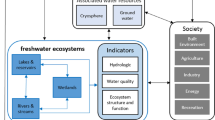Abstract
Freshwater bodies include a small fraction of the earth's surface (0.5%) and the biosphere's production. Freshwater productivity is difficult to estimate because of both problems of measurement and the great diversity of water bodies. A total production of 1.3×10 9 tons/year is suggested. Freshwater bodies are now subject to widespread unnatural fertilization or cultural eutrophication. While this process increases their productivity, in many cases it shifts that productivity into forms less suitable for use as human food.
Similar content being viewed by others
References
Aleem, A. A., and Samaan, A. A. (1969). Productivity of Lake Mariut, Egypt. Part II. Primary production.Internat. Rev. Gesammt. Hydrobiol. 54(4):491–527.
Allen, H. (1971). Primary productivity, chemo-organotrophy, and nutritional interactions of epiphytic algae and bacteria on macrophytes in the littoral of a lake.Ecol. Monogr. 41:97–121.
Beeton, A. M. (1969). Changes in the environment and biota of the Great Lakes. InEutrophication: Causes, Consequences and Correctives, National Academy of Sciences, Washington, D.C., pp. 150–197.
Culver, D. A., and Brunskill, G. J. (1969). Fayetteville Green Lake. V. Studies of primary production and zooplankton in a meromictic marl lake.Limnol. Oceanog. 14 (6):862–973.
Davis, C. C. (1966). Plankton Studies in the Largest Great Lakes of the World, University of Michigan, Great Lakes Research Division Publications, No. 14, pp. 1–36.
Edmondson, W. T. (1969). Eutrophication in North America. InEutrophication: Causes, Consequences and Correctives, National Academy of Sciences, Washington, D.C., pp. 124–149.
Edmondson, W. T. (1972). Nutrients and phytoplankton in Lake Washington. In Likens, G. E. (ed.),Nutrients and Eutrophication, American Society of Limnology and Oceanography, Special Symposia Vol. 1, Lawrence, Kansas, pp. 172–193.
Findenegg, I. (1966). Phytoplankton and primärproduktion einiger ostschweizerischer Seen und des Bodensees.Schweiz. Z. Hydrol. 28:148–171.
Fisher, S. G., and Likens, G. E. (1972). Stream ecosystem: Organic energy budget.BioScience 22(1):33–35.
Fogg, G. E. (1969). Oxygen-versus14C-methodology. In Vollenweider, R. A. (ed.),A Manual on Methods for Measuring Primary Production in Aquatic Environments, IBP Handbook No. 12, F. A. Davis Co., Philadelphia, pp. 76–78.
Goldman, C. R. (ed.). (1966).Primary Productivity in Aquatic Environments, Memorias del Instituto Italiano Idrobiologia 18 (Suppl.), University of California Press, Berkeley.
Goldman, C. R. (1968). Aquatic primary production.Am. Zoologist 8:31–42.
Hasler, A. D., and Ingersoll, B. (1968). Dwindling lakes.Nat. Hist. 77(9):1–6.
Hobbie, J. E. (1964). Carbon 14 measurements of primary production in two arctic Alaskan lakes.Internat. Verein. Theoret. Angew. Limnol. 15:360–364.
Hogetsu, K., and Ichimura, S. (1954). Studies on the biological production of Lake Suwa. VI. The ecological studies on the production of phytoplankton.Jap. J. Bot. 14:280–303.
Hutchinson, G. E. (1957).A Treatise on Limnology, Vol. 1:Geography, Physics and Chemistry, Wiley, New York.
Hutchinson, G. E. (1970). The Biosphere.Sci Am. 223(3):45–53.
Hynes, H. B. N. (1963). Imported organic matter and secondary productivity in streams.Proc. 16th Internat. Congr. Zool. 4:324–329.
Jónasson, P. M., and Kristiansen, J. (1967). Primary and secondary production in Lake Esrom. Growth ofchironomus anthracinus in relation to seasonal cycles of phytoplankton and dissolved oxygen.Internat. Rev. Gesammt. Hydrobiol. 52:163–217.
Ketelle, M. J., and Uttormark, P. D. (1971). Problem Lakes in the United States, Technical Report 16010 EHR 12/71, Water Resources Center, University of Wisconsin, Madison.
Likens, G. E. (1972). Eutrophication and aquatic ecosystems. In Likens, G. E. (ed.),Nutrients and Eutrophication, American Society of Limnology and Oceanography, Special Symposia Vol. 1, Lawrence, Kansas, pp. 3–14.
Lund, J. W. G., Mackereth, F. J. H., and Mortimer, C. H. (1963). Changes in depth and time of certain chemical and physical conditions and of the standing crop ofAsterionella formosa Hass. in the North Basin of Windermere in 1947.Phil. Trans. Roy. Soc. (Lond.) 246B:255–290.
Mathiesen, H. (1963). Om planteplanktonets produktion af organisk stof nogle naeringsrige søer på Sjaelland.-Ferskvandsfiskeribladet 1963 (1,2), 8 pp.
Melack, J. M., and Kilham, P. (1971). Primary production by phytoplankton in East African alkaline lakes.Bull. Ecol. Soc. Am. 52(4):45.
Odum, H. T. (1956). Primary production in flowing waters.Limnol. Oceanog. 1(2): 102–117.
Oglesby, R. T. (1969). Effects of controlled nutrient dilution on the eutrophication of a lake. InEutrophication: Causes, Consequences and Correctives, National Academy of Sciences, Washington, D.C., pp. 483–493.
Penman, H. L. (1970). The water cycle.Sci. Am. 223(3):99–108.
Peterka, J. J., and Reid, L. A. (1968). Primary production and chemical and physical characteristics of Lake Ashtabula Reservoir, North Dakota.Proc. N. Dakota Acad. Sci. 22:138–156.
Rich, P. H., Wetzel, R. G., and VanThuy, N. (1971). Distribution, production and role of aquatic macrophytes in a southern Michigan marl lake.Freshwater Biol. 1:3–21.
Rodhe, W. (1958). The primary production in lakes: Some results and restrictions of the14 C methods.Rapport et Procés Verbaux de Reunion des Counseil Internat. Exploration de Mer 144:122–128.
Rodhe, W. (1969). Crystallization of eutrophication concepts in northern Europe. InEutrophication: Causes, Consequences and Correctives, National Academy of Sciences, Washington, D.C., pp. 50–64.
Russell-Hunter, W. D. (1970).Aquatic Productivity, Macmillan, New York.
Sorokin, Y. I. (1966). On the trophic role of chemosynthesis and bacterial biosynthesis in water bodies. In Goldman, C. R. (ed.),Primary Productivity in Aquatic Environments, Memorias dele Instituto Italiano Idrobiologia, 18 (Suppl.), University of California Press, Berkeley, pp. 187–205.
Walker, K. F. (1973). Studies on a saline lake ecosystem.Aust. J. Mar. Freshwat. Res. 24:21–71.
Westlake, D. F. (1963). Comparisons of plant productivity.Biol. Rev. 38:385–425.
Westlake, D. F. (1966). Some basic data for investigations of the productivity of aquatic macrophytes. In Goldman, C. R. (ed.),Primary Productivity in Aquatic Environments, Memorias dele Instituto Italiano Idrobiologia, 18 (Suppl.), University of California Press, Berkeley, pp. 229–249.
Westlake, D. F. (1969). Units and comparability. In Vollenweider, R. A. (ed.),A Manual on Methods for Measuring Primary Production in Aquatic Environments, IBP Handbook No. 12, F. A. Davis Co., Philadelphia, pp. 113–117.
Whittaker, R. H. (1970).Communities and Ecosystems, Macmillan, New York.
Vollenweider, R. A. (ed.) (1969).A Manual on Methods for Measuring Primary Production in Aquatic Environments, IBP Handbook No. 12, F. A. Davis Co., Philadelphia.
Author information
Authors and Affiliations
Rights and permissions
About this article
Cite this article
Likens, G.E. Primary production: Freshwater ecosystems. Hum Ecol 1, 347–356 (1973). https://doi.org/10.1007/BF01536731
Received:
Revised:
Issue Date:
DOI: https://doi.org/10.1007/BF01536731




